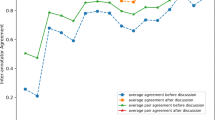Abstract
Nowadays, people tend to learn from the Web because it is convenient, and rich of free information. The main means of learning on the Web is by submitting a query to a search engine, and subsequently browsing through the returned results to find relevant information. Although in many cases, a search engine such as Google works quite well, the results returned are often not appropriate for the learning purpose. In this paper, we present a novel approach to automatically generate an E-textbook for a user specified topic hierarchy. Such a technology can ease the learning process to a great extent.
Similar content being viewed by others
Explore related subjects
Discover the latest articles, news and stories from top researchers in related subjects.References
S. Brin and L. Page, “The anatomy of a large-scale hypertextual web search engine,” in Proceedings of International Conference on World Wide Web, 1998.
S. Chakrabarti, Mining the Web: Discovering Knowledge from Hypertext Data, Morgan Kaufmann Publishers, 2002.
R. J. Cooper and S. M. Ruger, “A simple question answering system,” in Proceedings of TREC 9, 2000.
B. D. Davison, “Topical locality in the web,” ACM SIGIR, 2000.
DOM, http://www.w3.org/dom.
M. Halkidi, B. Nguyen, I. Varlamis, and M. Vazirgiannis, “THESUS: Organizing web document collections based on link semantics,” VLDB J. 12(4), 2003, 320–332.
S. Harabagiu, D. Moldovan, M. Pasca, R. Mihalcea, M. Surdeanu, R. Bunescu, R. Girju, V. Rus, and P. Morarescu, “FALCON: Boosting knowledge for answer engines,” in Proceedings of TREC 9, 2000.
J. Klavans and S. Muresan “DEFINDER: Rule-based methods for the extraction of medical terminology and their associated definitions from on-line text,” in Proc. of AMIA, Los Angeles, CA, 2000, pp. 201–202.
D. J. Lawrie, “Language models for hierarchical summarization,” PHD thesis, 2003, http://www-ciir.cs.umass.edu/~lawrie/
B. Liu, C.-W. Chin, and H.-T. Ng, “Mining topic-specific concepts and definitions on the web,” in Proceedings of International Conference on World Wide Web, 2003, pp. 251–260.
Open Directory. http://dmoz.org.
M. F. Porter, “An algorithm for suffix stripping,” Program 14(3), 1980, 130–137.
Y. Qiu and H.-P. Frei, “Concept-based query expansion,” in Proceedings of SIGIR, 1993, pp. 160–169.
E. M. Voorhees, “Query Expansion Using Lexical-Semantic Relations,” in Proceedings of the 17th International ACM SIGIR Conference on Research and Development in Informational Retrieval, 1994, pp. 61–69.
Zh. Zhang, J. Chen, and X. LI, “A preprocessing framework and approach for Web applications,” Journal of Web Engineering 2(3), 2004, 175–191.
Author information
Authors and Affiliations
Corresponding author
Rights and permissions
About this article
Cite this article
Chen, J., Li, Q. & Jia, W. Automatically Generating an E-textbook on the Web. World Wide Web 8, 377–394 (2005). https://doi.org/10.1007/s11280-005-1319-5
Published:
Issue Date:
DOI: https://doi.org/10.1007/s11280-005-1319-5




